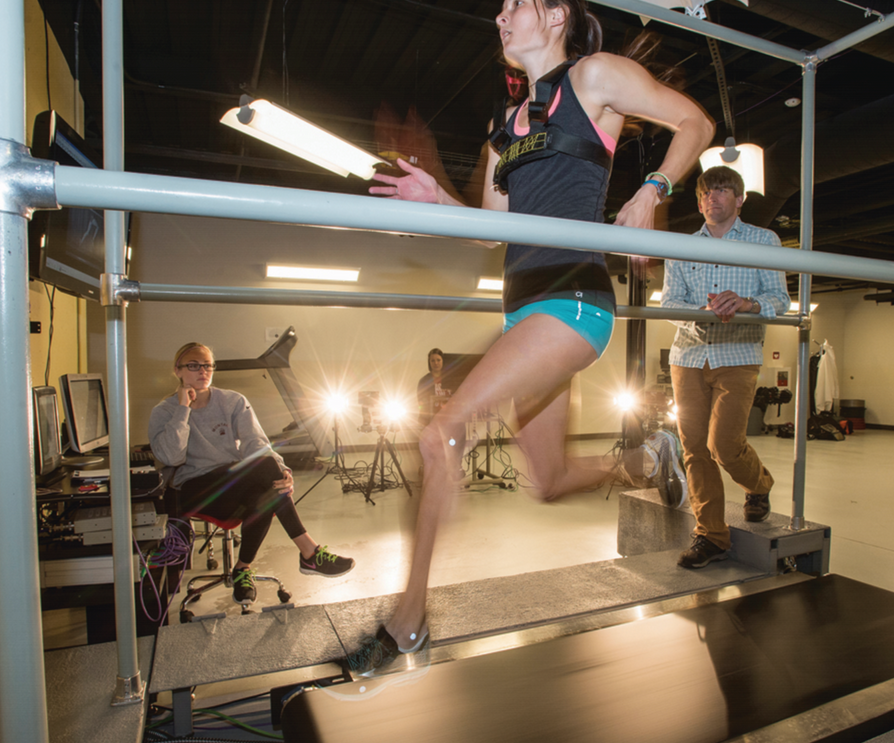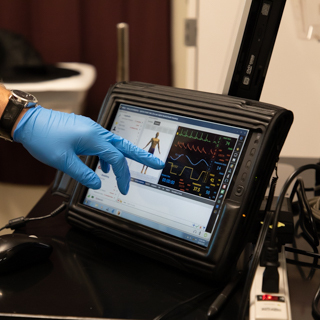Biomechanics Laboratory

Location: Phyllis J. Washington Education Center, Room 010
Dr. Matt Bundle, Director
School of Integrative Physiology and Athletic Training
Email: matt.bundle@umontana.edu
Phone: (406) 243-4582
Links
- ESPN 30 for 30 (Dr. Bundle Episode 2)
- Religion of Sport False Idol - Re-exploring the tragic story of sprinter Oscar Pistorius and Reeva Steenkamp
- Esteemed Human-Performance Researcher Joins University of Montana
- Dr. Matt Bundle in the New York Times
Mysteries of the body (Story by Erika Fredrickson*)

Photo by: Todd Goodrich
Matt Bundle was first inspired by the famous Harvard physiologist C. Richard Taylor, known for, among other things, putting wild animals on treadmills to study their locomotion and design. Bundle was an undergrad at Harvard in the mid-1990s and captain of the school’s track and field team when he heard about Taylor’s work. He decided to take some classes from him, though he had no intention of making a career out of it.
“The connection between movement and anatomy and physiology felt to me, at the time, a tremendous marriage of my interests,” Bundle says. “But I had no idea that people pursued it as a legitimate course of study.”
Earlier in his career, Taylor worked in Africa experimenting with how variables change in animals of different sizes and how they maintain body temperature in some of the hottest climes on Earth. Bundle recalls the 16 mm films they watched in class showing Taylor in a Sherlock Holmes-style hat chasing wild African animals around a pen as they were hooked up to metabolic machines. Bundle went on to work in Taylor’s laboratory at the Concord Field Station in Harvard’s Museum of Comparative Zoology.
Now an exercise science professor at UM, Bundle has his own laboratory where he studies the way human bodies work. Inside the basement of the Phyllis J. Washington Education Center, you can find what looks like a futuristic fitness gym: a stationary bike hooked up to machines; a custom ergometer that looks half-weight machine, half bike; and an oversized treadmill.
There are no wild antelope, but you might find a Montana Grizzly athlete racing across the conveyor belt. This treadmill is one of two in the world that can measure the force of weight each footfall creates at the limit of human gait and speed.
And it helps to examine one of the many mysteries of the human body.
“If your event specialty is 60 meters or 100 meters and you’ve had competitive success, you would be able to typically throw about five times your body weight each step—peak, not average—against the ground,” Bundle says. “But we could take this person over to the gym and load up five-times the body’s weight and there will be no way they can support it. And so this is one of the things we are interested in. It’s a basic neuromuscular question about how we do it.”
Bundle, who got his doctorate in biology from UM and a postdoctoral degree at Rice University, returned to UM to teach three years ago. By then he had made news: He and a colleague made waves with their work proving double-amputee Olympic runner Oscar Pistorius had a clear advantage with his prosthetic legs over other runners.
He is one of UM’s many HHP professors in the exercise science program exploring questions about the science of the human body. It focuses on three tracks: the preprofessional track, which often leads to careers in medicine and physical therapy; the applied track, which prepares students to be fitness trainers; and the pre-athletic track, which preps undergrads for athletic training degrees that can lead to work in collegiate and professional sports.
The work students do is far from insular. This year marks fifty years of consulting with the U.S. Forest Service on health and performance issues for wildland firefighters. Students also work with UM’s physical therapy program, as well as off-campus programs such as the International Heart Institute of Montana and engineering companies. As part of HHP’s Exercise, Aging, and Disease class, students have helped alert faculty and staff members of their own health issues.
“It’s a great integrative approach where they get to use a lot of the information they have been studying,” Bundle says. “They bring in people from the University community, some of whom are at risk for coronary events, and work with them to make a positive change.”
Though Bundle’s career first was driven by a fascination with athletic performance, almost everything he does with his students also has promise for the health of average humans.
“The exercise science faculty are broadly interested in the health benefits of exercise,” Bundle says. “I look at how legs are designed and what that means for things like stiffness and how much compression should be happening. That can inform the development of new techniques for people who want to run faster, or inform the design of shoes, or the design of prostheses. But all these elements can improve ambulation, physical activity, and the health of different segments of our population.”
*Erika Fredrickson is the former arts editor at the Missoula Independent. She graduated from UM’s Creative Writing Program in 1999 and earned a master’s degree in environmental studies in 2009.
